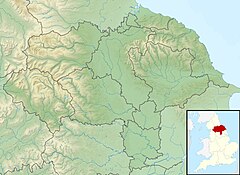Barden Tower
| Barden Tower | |
|---|---|
Anne Clifford | |
| Current use | Tower derelict House used as cafe |
| Owner | Bolton Abbey Estate[1] |
Barden Tower is a ruined building in the Parish of Barden, in
History
The tower is located equidistant between Bolton Bridge on the A59 road to the south, and the village of Burnsall to the north (4 miles (6.4 km) each way).[3] A lodge of sorts had been located in the Forest of Barden since early Plantagenet times, but it was rebuilt in stone c.1485–1490 by Henry Clifford, who was also known as the Lord Shepherd.[note 1][4][5][6] Clifford chose the area around Barden as his main residence over his castle at Skipton.[7] Barden Tower was one of six forest lodges which were in the possession of the Clifford family between the 14th and 17th centuries. Besides Barden, the Cliffords had lodges at Drebley, Gamsworth, Howgill and Laund. The sixth lodge at a site known as Ungaine, has not yet been identified.[note 2][8][9] The tower became the focal point for the hamlets and farmhouses in the area; because there was no nuclear village to gather to, the tower became a de facto village centre.[10]
The tower, along with the chapel next to it and
During the
The second roof was made out of lead, and it was de-roofed again c. 1800, but the buildings were still the focal point for those who lived around it, which had become easier since the opening of Barden Bridge in 1659.
In 1881, a 3,500-tonne (3,900-ton) steam ship was named Barden Tower on the River Tyne in Northumberland. She sank in the English Channel in 1893.[19]
All three historical buildings on the site were
See also
Gallery
-
Barden Tower rear
-
Barden Tower from Barden Scale
-
Barden Tower
-
Barden Tower
-
Peter DeWint - Barden Tower, Yorkshire
Notes
- Battle of Bosworth.
- ^ Speight lays claim to Ungaine (Ungayne) being directly east of the Priory at Bolton on the left bank of the river.
References
- ^ Briggs, Ian (25 November 2005). "Down-to-earth matters from the man at the helm". The Yorkshire Post. Retrieved 2 April 2019.
- ^ "North Yorkshire and York Landscape Characterisation Project" (PDF). northyorks.gov.uk. Chris Blandford Associates. May 2011. p. 92. Retrieved 2 April 2019.
- ^ "Bolton Abbey | Barden Tower". boltonabbey.com. Retrieved 2 April 2019.
- required.)
- ^ Beaumont 1996, p. 69.
- ^ a b c Speight 1900, p. 351.
- ^ "Out of Oblivion: A landscape through time". www.outofoblivion.org.uk. Retrieved 2 April 2019.
- ^ Speight 1900, p. 356.
- ^ Beaumont 1996, p. 68.
- ^ Beaumont 1996, p. 67.
- required.)
- ^ Historic England. "Barden Tower (48258)". Research records (formerly PastScape). Retrieved 2 April 2019.
- ^ Lockwood, Ian (29 July 2005). "Priest's House, Barden". Craven Herald. Retrieved 2 April 2019.
- ^ Quantrill, Tim (26 September 2014). "A pleasant walk with lovely viewpoints". Retrieved 10 April 2019 – via Newsbank.
- ISBN 978-1-85284-943-6.
- ^ a b Speight 1900, p. 357.
- ^ Historic England. "Barden Bridge (Grade II) (1131759)". National Heritage List for England. Retrieved 9 April 2019.
- ^ Beaumont 1996, p. 71.
- ^ "Barden Tower 1881". www.tynebuiltships.co.uk. Retrieved 2 April 2019.
- ^ Historic England. "Barden Tower (Grade I) (1317012)". National Heritage List for England. Retrieved 2 April 2019.
- ^ Historic England. "Barden Tower Farmhouse (Grade I) (1317013)". National Heritage List for England. Retrieved 2 April 2019.
- ^ Historic England. "Barden Church (Grade I) (1131761)". National Heritage List for England. Retrieved 2 April 2019.
- ^ Thompson, Stuart (9 June 2016). "Renovated Priests House and Old Chapel at Bolton Abbey estate's Barden Tower offers new menu". Craven Herald. Retrieved 2 April 2019.
- ISBN 978-1-40937-104-5.
- ^ Historic England. "Barden Tower medieval fortified house and medieval garden earthworks (1015417)". National Heritage List for England. Retrieved 2 April 2019.
- ^ "Wharfedale and Littondale Landscape Character Assessment" (PDF). yorkshiredales.org.uk. p. 3. Retrieved 9 April 2019.
- ^ Midgley, Carol (19 June 2009). "Times Walks: Bolton Abbey and the Strid, Yorkshire". The Times. Retrieved 9 April 2019.
Sources
- Beaumont, Heather (May 1996). "Tracing the evolution of an estate township: Barden in Upper Wharfedale". The Local Historian. 26 (2). Leicester: British Association for Local History. ISSN 0024-5585.
- Speight, Harry (1900). Upper Wharfedale. Being a complete account of the history, antiquities and scenery of the picturesque valley of the Wharfe, from Otley to Langstrothdale. London: Elliott Stock. OCLC 1079273371.






